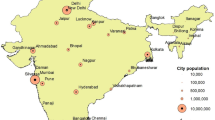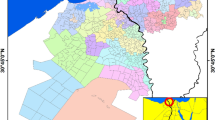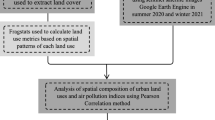Abstract
In Tunisia, urban air pollution is becoming a bigger problem. This study used a combined strategy of biomonitoring with lichens and satellite mapping with Sentinel-5 satellite data processed in Google Earth Engine (GEE) to assess the air quality over metropolitan Tunis. Lichen diversity was surveyed across the green spaces of the Faculty of Science of Tunisia sites, revealing 15 species with a predominance of pollution-tolerant genera. The Index of Atmospheric Purity (IAP) calculated from the lichen data indicated poor air quality. Spatial patterns of pollutants sulfur dioxide (SO2), ozone (O3), nitrogen dioxide (NO2), carbon monoxide (CO), and aerosol index across Greater Tunis were analyzed from Sentinel-5 datasets on the GEE platform. The higher values of these indices in the research area indicate that it may be impacted by industrial activity and highlight the considerable role that vehicle traffic plays in air pollution. The results of the IAP, IBL, and the combined ground-based biomonitoring and satellite mapping techniques confirm poor air quality and an environment affected by atmospheric pollutants which will enable proactive air quality management strategies to be put in place in Tunisia’s rapidly expanding cities.











Similar content being viewed by others
Data availability
Not applicable.
References
Abas, A., Aiyub, K., & Awang, A. (2022a). Biomonitoring potentially toxic elements (PTEs) using lichen transplant Usnea misaminensis: A case study from Malaysia. Sustainability, 14(12), 7254. https://doi.org/10.3390/su14127254
Abas, A., Asnawi, N. H., Aiyub, K., Awang, A., & Abdullah, S. R. (2022). Lichen Biodiversity Index (LBI) for the assessment of air quality in an industrial city in Pahang Malaysia. Atmosphere, 13, 11. https://doi.org/10.3390/atmos13111905
AL-Alam, J., Chbani, A., Faljoun, Z., & Millet, M. (2019). The use of vegetation, bees, and snails as important tools for the biomonitoring of atmospheric pollution—A review. Environmental Science and Pollution Research, 26(10), 9391–9408. https://doi.org/10.1007/s11356-019-04388-8
Belguidoum, A., Haichour, R., Lograda, T., & Ramdani, M. (2022). Biomonitoring of air pollution by lichen diversity in the urban area of Setif. Biodiversitas Journal of Biological Diversity, 23, 2. https://doi.org/10.13057/biodiv/d230240
Bikis, A. (2023). Urban air pollution and greenness in relation to public health. Journal of Environmental and Public Health, 2023, 1–18. https://doi.org/10.1155/2023/8516622
Boustie, J., & Grube, M. (2005). Lichens—A promising source of bioactive secondary metabolites. Plant Genetic Resources, 3(2), 273–287. https://doi.org/10.1079/PGR200572
Calvelo, S., Baccalá, N., & Liberatore, S. (2009). Lichens as bioindicators of air quality in distant areas in Patagonia (Argentina). Environmental Bioindicators, 4(2), 123–135. https://doi.org/10.1080/15555270902963459
Cernat Popa, M. M., & Rusănescu, C. O. (2023). The efficiency of lichens in air biomonitoring in Teleorman county. Atmosphere, 14(8), 1287. https://doi.org/10.3390/atmos14081287
Chahloul, N., Khadhri, A., Vannini, A., Mendili, M., Raies, A., & Loppi, S. (2022). Bioaccumulation of potentially toxic elements in some lichen species from two remote sites of Tunisia. Biologia. https://doi.org/10.1007/s11756-022-01069-9
Chahloul, N., Khadhri, A., Vannini, A., Mendili, M., Raies, A., & Loppi, S. (2023). Selecting the species to be used in lichen transplant surveys of air pollution in Tunisia. Environmental Monitoring and Assessment, 195(5), 570. https://doi.org/10.1007/s10661-023-11219-4
Contardo, T., Vannini, A., Sharma, K., Giordani, P., & Loppi, S. (2020). Disentangling sources of trace element air pollution in complex urban areas by lichen biomonitoring. A case study in Milan (Italy). Chemosphere, 256, 127155. https://doi.org/10.1016/j.chemosphere.2020.127155
Conti, M. E., & Cecchetti, G. (2001). Biological monitoring: Lichens as bioindicators of air pollution assessment — A review. Environmental Pollution, 114(3), 471–492. https://doi.org/10.1016/S0269-7491(00)00224-4
Coste, C. (2011). Ecologie et fonctionnement des communautés lichéniques saxicoles- hydrophiles, pp 1–142.. Université Toulouse 3 Paul Sabatier
Dörter, M., Karadeniz, H., Saklangıç, U., & Yenisoy-Karakaş, S. (2020). The use of passive lichen biomonitoring in combination with positive matrix factor analysis and stable isotopic ratios to assess the metal pollution sources in throughfall deposition of Bolu plain. Turkey. Ecological Indicators, 113, 106212. https://doi.org/10.1016/j.ecolind.2020.106212
Duncan, B. N., Prados, A. I., Lamsal, L. N., Liu, Y., Streets, D. G., Gupta, P., Hilsenrath, E., Kahn, R. A., Nielsen, J. E., Beyersdorf, A. J., Burton, S. P., Fiore, A. M., Fishman, J., Henze, D. K., Hostetler, C. A., Krotkov, N. A., Lee, P., Lin, M., Pawson, S., & Ziemba, L. D. (2014). Satellite data of atmospheric pollution for U.S. air quality applications: Examples of applications, summary of data end-user resources, answers to FAQs, and common mistakes to avoid. Atmospheric Environment, 94, 647–662. https://doi.org/10.1016/j.atmosenv.2014.05.061
Estrabou, C., Filippini, E., Soria, J. P., Schelotto, G., & Rodriguez, J. M. (2011). Air quality monitoring system using lichens as bioindicators in Central Argentina. Environmental Monitoring and Assessment, 182(1–4), 375–383. https://doi.org/10.1007/s10661-011-1882-4
Gavériaux, J.-P. (1999). LICHENS et QUALITÉ de l’AIR (initiation) pp1–10.
Gombert, S., Asta, J., & Seaward, M. (2004). Assessment of lichen diversity by index of atmospheric purity (IAP), index of human impact (IHI) and other environmental factors in an urban area (Grenoble, southeast France). Science of the Total Environment, 324(1–3), 183–199. https://doi.org/10.1016/j.scitotenv.2003.10.036
Grimm, M., Grube, M., Schiefelbein, U., Zühlke, D., Bernhardt, J., & Riedel, K. (2021). The lichens’ microbiota, still a mystery? In Frontiers in Microbiology, (Vol. 12, pp.1–25). Frontiers Media S.A.https://doi.org/10.3389/fmicb.2021.623839
Hauck, M., Jürgens, S.-R., Brinkmann, M., & Herminghaus, S. (2008). Surface hydrophobicity causes SO2 tolerance in lichens. Annals of Botany, 101(4), 531–539. https://doi.org/10.1093/aob/mcm306
Holloway, T., Miller, D., Anenberg, S., Diao, M., Duncan, B., Fiore, A. M., Henze, D. K., Hess, J., Kinney, P. L., Liu, Y., Neu, J. L., O, S. M., Talat Odman, M., Bradley Pierce, R., Russell, A. G., Tong, D., Jason West, J., Zondlo, M. A. (2021). Downloaded from www.annualreviews.org Access provided by 170.140.97.180 on 07/20/21. For personal use only. Annu. Rev. Biomed. Data Sci, 4, 417–447. https://doi.org/10.1146/annurev-biodatasci-110920
Kazemi Garajeh, M., Laneve, G., Rezaei, H., Sadeghnejad, M., Mohamadzadeh, N., & Salmani, B. (2023). Monitoring trends of CO, NO2, SO2, and O3 pollutants using time-series Sentinel-5 images based on Google Earth Engine. Pollutants, 3(2), 255–279. https://doi.org/10.3390/pollutants3020019
Khairuddin, N. A., Muhammad, N., Hashim, N. H., Yusof, H., Jusoh, S., Abas, A., Talip, B. A., Abdullah, N., & Din, L. B. (2017). Identification of most tolerant lichen species to vehicular traffic’s pollutants at Batu Pahat area. AIP Conference Proceedings, 1891, 020078. https://doi.org/10.1063/1.5005411
Larsen, R. S., Bell, J. N. B., James, P. W., Chimonides, P. J., Rumsey, F. J., Tremper, A., & Purvis, O. W. (2007). Lichen and bryophyte distribution on oak in London in relation to air pollution and bark acidity. Environmental Pollution, 146(2), 332–340. https://doi.org/10.1016/j.envpol.2006.03.033
Lättman, H., Bergman, K.-O., Rapp, M., Tälle, M., Westerberg, L., & Milberg, P. (2014). Decline in lichen biodiversity on oak trunks due to urbanization. Nordic Journal of Botany, 32(4), 518–528. https://doi.org/10.1111/j.1756-1051.2013.00413.x
Lawal, O., Ogugbue, C. J., & Imam, T. S. (2023). Mining association rules between lichens and air quality to support urban air quality monitoring in Nigeria. Heliyon, 9(1), e13073. https://doi.org/10.1016/j.heliyon.2023.e13073
Mamić, L., Gašparović, M., & Kaplan, G. (2023). Developing PM2.5 and PM10 prediction models on a national and regional scale using open-source remote sensing data. Environmental Monitoring and Assessment, 195(6), 644. https://doi.org/10.1007/s10661-023-11212-x
Manisalidis, I., Stavropoulou, E., Stavropoulos, A., & Bezirtzoglou, E. (2020). Environmental and health impacts of air pollution: A review. Frontiers in Public Health, 8, 1–13. https://doi.org/10.3389/fpubh.2020.00014
Mannucci, P. M., & Franchini, M. (2017). Health effects of ambient air pollution in developing countries. In International Journal of Environmental Research and Public Health, 14, 9. https://doi.org/10.3390/ijerph14091048
Mejía, C. D., Alvarez, H., Zalakeviciute, R., Macancela, D., Sanchez, C., & Bonilla, S. (2023). Sentinel satellite data monitoring of air pollutants with interpolation methods in Guayaquil, Ecuador. Remote Sensing Applications: Society and Environment, 31, 100990. https://doi.org/10.1016/j.rsase.2023.100990
Mendili, M., Jrad, T. B., & Khadhri, A. (2023). Lichen diversity and bioaccumulation of heavy metals in northern Tunisia: A study to evaluate environmental pollution. Euro-Mediterranean Journal for Environmental Integration. https://doi.org/10.1007/s41207-023-00413-y
Nascimbene, J., Benesperi, R., Giordani, P., Grube, M., Marini, L., Vallese, C., & Mayrhofer, H. (2019). Could hair-lichens of high-elevation forests help detect the impact of global change in the Alps? Diversity, 11(3), 45. https://doi.org/10.3390/d11030045
Riggs, D. W., Yeager, R., Conklin, D. J., DeJarnett, N., Keith, R. J., DeFilippis, A. P., Rai, S. N., & Bhatnagar, A. (2021). Residential proximity to greenness mitigates the hemodynamic effects of ambient air pollution. American Journal of Physiology-Heart and Circulatory Physiology, 320(3), H1102–H1111. https://doi.org/10.1152/ajpheart.00689.2020
Rosli, N. S., & Zulkifly, S. (2022). Application of Index of Atmospheric Purity (IAP) along elevation gradients in Gunung Jerai, Kedah Malaysia. Environmental Monitoring and Assessment, 194, 7. https://doi.org/10.1007/s10661-022-10108-6
Seed, L., Wolseley, P., Gosling, L., Davies, L., & Power, S. A. (2013). Modelling relationships between lichen bioindicators, air quality and climate on a national scale: Results from the UK OPAL air survey. Environmental Pollution, 182, 437–447. https://doi.org/10.1016/j.envpol.2013.07.045
Shami, S., Ranjgar, B., Azar, M. K., Moghimi, A., Sabetghadam, S., & Amani, M. (2021). Trends of CO and NO2 pollutants change in Iran during COVID-19 pandemic using time-series Sentinel-5 images in Google Earth Engine, pp 1–18. https://doi.org/10.21203/rs.3.rs-773367/v2
Tabunschik, V., Gorbunov, R., & Gorbunova, T. (2023). Unveiling air pollution in Crimean Mountain Rivers: Analysis of Sentinel-5 satellite images using Google Earth Engine (GEE). Remote Sensing, 15(13), 3364. https://doi.org/10.3390/rs15133364
Van Haluwyn, C. L. M. (1986). Les lichens et la qualité de l’air: évolution méthodologique et limites, pp 213–213. Ministère de l’Environnement
Zhang, Y., Li, Z., Bai, K., Wei, Y., Xie, Y., Zhang, Y., Ou, Y., Cohen, J., Zhang, Y., Peng, Z., Zhang, X., Chen, C., Hong, J., Xu, H., Guang, J., Lv, Y., Li, K., & Li, D. (2021). Satellite remote sensing of atmospheric particulate matter mass concentration: Advances, challenges, and perspectives. Fundamental Research, 1(3), 240–258. https://doi.org/10.1016/j.fmre.2021.04.007
Author information
Authors and Affiliations
Contributions
The authors confirm their contribution to the paper: Ayda Khadhri and Mohamed Mendili conceived and designed the experiments, performed the experiments, analyzed and interpreted the data, and wrote and edited the article. Zahra Sellami and Rania Somai performed the experiments and analyzed and interpreted the data. All authors reviewed the results and approved the final version of the manuscript.
Corresponding author
Ethics declarations
Ethical statement
Not applicable.
Competing interests
The authors declare no competing interests.
Additional information
Publisher's Note
Springer Nature remains neutral with regard to jurisdictional claims in published maps and institutional affiliations.
Rights and permissions
Springer Nature or its licensor (e.g. a society or other partner) holds exclusive rights to this article under a publishing agreement with the author(s) or other rightsholder(s); author self-archiving of the accepted manuscript version of this article is solely governed by the terms of such publishing agreement and applicable law.
About this article
Cite this article
MENDILI, M., SELLAMI, Z., SOMAI, R. et al. Assessing Tunisia’s urban air quality using combined lichens and Sentinel-5 satellite integration. Environ Monit Assess 196, 545 (2024). https://doi.org/10.1007/s10661-024-12705-z
Received:
Accepted:
Published:
DOI: https://doi.org/10.1007/s10661-024-12705-z




